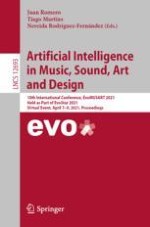2021 | Book
Artificial Intelligence in Music, Sound, Art and Design
10th International Conference, EvoMUSART 2021, Held as Part of EvoStar 2021, Virtual Event, April 7–9, 2021, Proceedings
Editors: Juan Romero, Tiago Martins, Nereida Rodríguez-Fernández
Publisher: Springer International Publishing
Book Series : Lecture Notes in Computer Science
